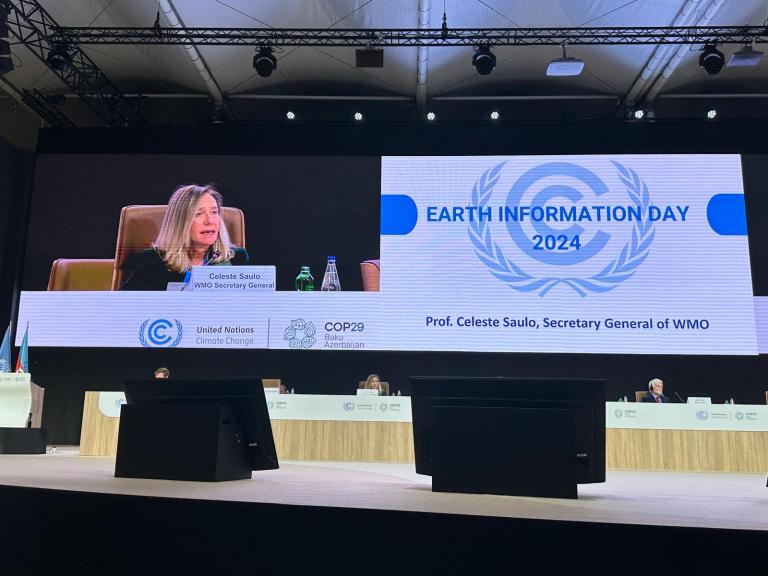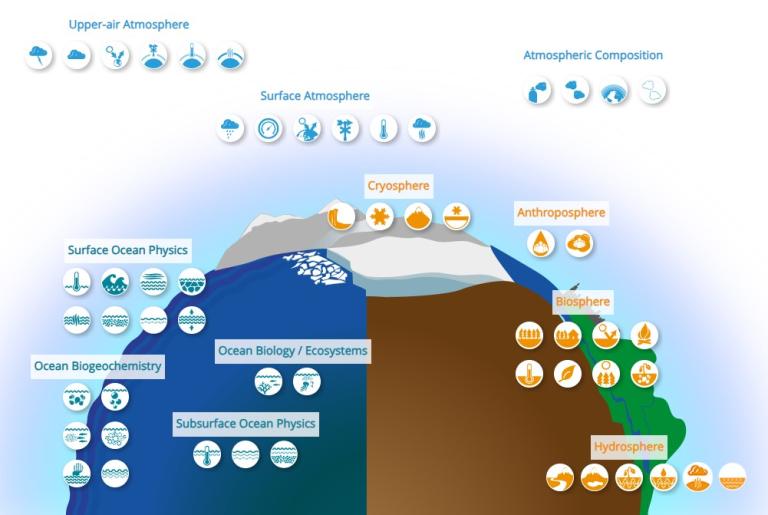WMO at COP29: Close the gap in Earth Observations
The UN Framework Convention on Climate Change Subsidiary Body for Scientific and Technological Advice (SBSTA) has recognized the importance of Earth observations and related long-term data records in its concluding document at COP29, reflecting the central role of the WMO community in the UN Climate Change negotiations process.

SBSTA took note of the 2023 WMO Greenhouse Gas Bulletin and the WMO State of the Climate 2024 Update, for COP29, along with statements delivered by WMO and GCOS (Global Climate Observing System) in the opening plenary. SBSTA “expressed utmost concern about the state of the global climate system, with record high atmospheric greenhouse gas concentrations being observed in 2023, with 2024 being on track to be the hottest year on record, which is primarily a result of the long-term warming caused by emissions from pre-industrial times until now. It noted the information provided on changes in the climatic system, both slow onset and extreme events, occurring globally.”
The conclusions by the SBSTA Chair recognized the vital importance of robust Earth observation systems and related long-term data records …. for enhanced understanding of changes in the global climate system and their attribution, mitigation and adaptation action, efforts to avert, minimize and address loss and damage, and early warning systems, and the importance of observational data, including to the work of the Intergovernmental Panel on Climate Change (IPCC).”
“Without a global observing system for climate you do not have the robust evidence basis needed to understand climate change and inform decision makers,” according to Thelma Krug, chair of GCOS.
“Observations are a foundational element for climate related policy. They are at the beginning of the value chain for mitigation, adaptation, loss and damage, climate predictions, climate services,” she said.
In Baku, Azerbaijan, as at all previous COPs, WMO stressed the need to strengthen and expand Earth Observations. This includes more sustained and coordinated monitoring from surface stations and from space, including greater effort on greenhouse gases.
WMO made an extensive presentation on the State of the Climate 2024 Update at Earth Information Day on day 1 of COP29, which was subsequently summarised for SBSTA considerations during week 1 of COP. The State of the Climate Update reports that year 2024 is on track to be the hottest on record and temporarily hit 1.5°C above the pre-industrial era, but the report and WMO statement in opening plenary note that long-term warming, measured over decades, still remains below 1.5°C.
The SBSTA is one of the central planks of the UNFCCC process. WMO, its Members and partners provide detailed input to SBSTA and attach high importance to its conclusions.
Parties reached consensus on the Research and Systematic Observations conclusions due to their urgency, but did not reach conclusions on many remaining items which will now be discussed at the next SBSTA in June 2025.

Global Greenhouse Gas Watch
The SBSTA noted the progress made by the Global Greenhouse Gas Watch initiative, aimed at establishing sustained, routine global monitoring of greenhouse gas concentrations and fluxes. It recognized that this initiative is intended to improve the quantification of both natural and anthropogenic greenhouse gas sources and sinks, and to complement emission inventories, noting that reporting and greenhouse gas inventory guidelines are as adopted under the Convention and the Paris Agreement.
The Global Greenhouse Gas Watch is one of WMO’s top initiatives to strengthen support for policy-making.
It provides an operational framework for all space-based and surface-based observing systems, as well as modelling and data assimilation capabilities. It brings the research and operational communities together.
“Through the Global Greenhouse Gas Watch, we will provide more information to monitor the effectiveness of mitigation actions under the Paris Agreement. The need is more urgent than ever before,” said Celeste Saulo.
Early Warnings For All
The SBSTA emphasized the urgent need to maintain and expand systematic observations in support of adaptation, as well as deliver Early Warnings for All, a key global initiative for protecting those most vulnerable to the impacts of extreme weather and climate events.
The SBSTA “noted with appreciation the support being provided for addressing gaps in systematic observations in developing countries, also noted the continued efforts of the Systematic Observations Financing Facility, which currently prioritizes systematic observations in the least developed countries and small island developing States.”
It invited the Facility to consider extending its support for systematic observations to more countries. It encouraged Parties and relevant organizations to further strengthen their provision of support to the systematic observation community.

Global Climate Observing System
GCOS provides the climate observational requirements needed to collect robust, accurate and timely Essential Climate Variables (ECVs). These are physical, chemical or biological variable or a group of linked variables that critically contributes to the characterization of Earth’ s climate. GCOS currently specifies 55 ECVs.
It also promotes the curation and sharing of historical data needed to produce better climate reanalysis products which are needed in turn to improve Numerical Weather Prediction and new Artificial Intelligence based forecast products.
“This is of increasing relevance for real-time warnings in the context of the international Early Warnings for All initiative. Unfortunately, we have significant gaps in both the observing systems and the coordination of observations in terms of geographical coverage, monitoring capacity, long-term data preservation and access to data,” said Celeste Saulo.
For instance, both the daily average and the annual totals of the radiosondes launched within the GCOS Global Upper Air Network have systematically declined by around 9% since the highest values in 2016/2017, and the number of long-term inactive GUAN stations has increased significantly over the last 4 years. This is most likely due to resource constraints.
Hence, it is important that the Global Basic Observing Network (GBON) is fully implemented to help fill in persistent gaps in critical regions. The long-term and sustained contribution from the Systematic Observations Financing Facility is fundamental to help sustain existing networks in need as well as new ones. Gaps are especially severe in Africa.
By contrast, satellites are allowing, more than ever, the observation of many aspects of the global earth system.
“We cannot afford to make perfectly understood measurements everywhere and nor do we need it. We do need perfectly understood measurements at sufficient points to anchor and understand remaining observations,” said Thelma Krug.
She said that it is imperative to encourage and fund multiple independent datasets production effort for each and every ECV.
“Arguably the only ones we have sufficient independent estimates are for ocean heat content; sea level; and very recently – surface temperatures;” she said.
“For everything else there is an insufficient number of independent estimates and that has negative implications for scientific understanding and possibly for policy making,” she said.










